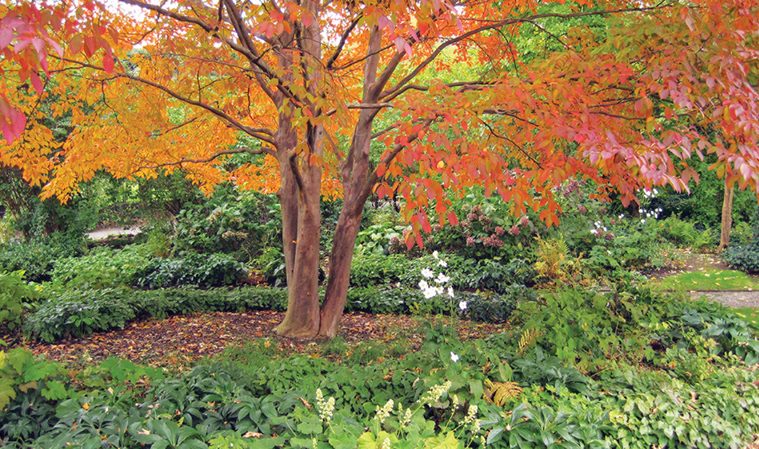A choice tree can be the difference between ho-hum and ooh-ahh.
The small- to medium-sized deciduous tree provides year-round interest in the garden with its sinewy branching habit (draped in freshly fallen snow, the effect is bewitching); mottled bark; showy white camellia-like flowers in late spring/early summer (after most trees have stopped blooming); persistent green capsule fruits; and surreal fall foliage, which bleeds from brilliant red-orange to deep dark wine.
The slow-growing Stewartia is considered a valuable specimen tree, meaning it ought to be planted where its unique qualities will be showcased as the seasons turn. Native to Japan and Korea, it thrives in part sun/part shade, but will grow in full sun or full shade. It tolerates most soil types, but requires good drainage and even moisture. Because the bark is thin and easily damaged, it should be placed where mechanical impact from lawnmowers, weed whackers, edgers, etc., is unlikely.
Highly disease and pest resistant, it is also a very “clean” tree, i.e., it doesn’t shed messy foliage or fruit droppings. All told, Japanese Stewartia is a well-behaved, noninvasive species worthy of widespread use.
For real plant enthusiasts, interesting cultivars include ‘Mint Frills’—known for its ruffled green-tinged flower petals; ‘Balle’—a selection out of the Polly Hill Arboretum on Martha’s Vineyard featuring a more spreading habit and larger flowers (almost four inches wide); ‘Cascade’—a semi-weeping form with graceful drooping branches; ‘Milk and Honey,’ which is a little harder to find and known for its profuse quantities of large blooms and bright bark color; and ‘Pink Form’—a rare selection with pale white-pink flowers opening from attractive pinkish buds.
Of course, the straight-up species pseudocamellia is spectacular—and ideal for that special place in the garden toward which the eye is perpetually drawn.
Quick Facts
Botanical name: Stewartia pseudocamellia
Common name: Japanese Stewartia
Size: 30 to 40 feet tall and 25 to 30 feet spread
Cultural requirements: part sun/part shade, even moisture, and good drainage
Uses: as a specimen tree in small gardens, patio areas, and entryways; as a canopy tree in the corner of a garden or over a sidewalk; for creating an allée in a formal setting
Sources
Corliss Brothers
31 Essex Rd., Ipswich, 978-356-5422
corlissbrothers.com
New England Nurseries
216 Concord Rd., Bedford, 781-275-2525
newenglandnurseries.com
Wolf Hill Home & Garden
104 Eastern Ave., Gloucester, 978-281-4480
60 Turnpike Rd., Ipswich, 978-356-6342
wolfhillhomeandgardencenter.com

